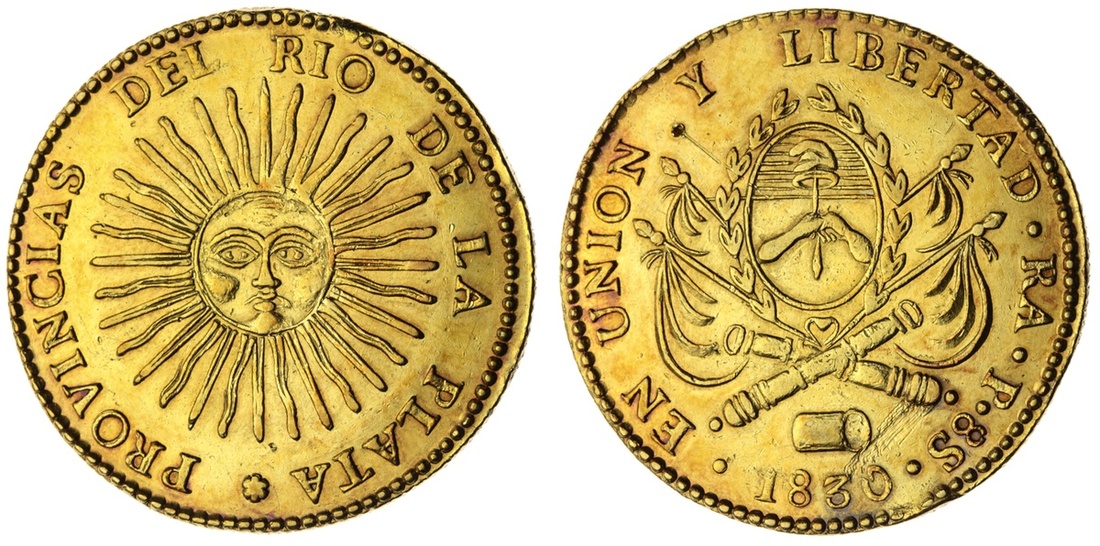
Auction: 374 - The Numismatic Collector's Series Sale at NYINC
Lot: 248
(x) Argentina, 17-Pesos or 8-Escudos, 1830 RA P, La Rioja [under Lamadrid], PROVINCIAS DEL RIO DE LA PLATA, blazing sun, rev. EN UNION Y LIBERTAD RA P 8S 1830, seal of the Constitutional General Assembly of 1813, blue chief occupying half the shield (barry), with hands clasped holding a pike with a Phrygian cap, flags flanking surrounding laurel wreath, traversed cannons saltire and drum below, edge obliquely grained, 27.27g, 6h (Fb. 2; KM 21; Onza 1563), some minor edge bruising, a trace of tooling above date and a pinhole scratch at 10 o'clock, otherwise lustrous with hints of peripheral reddish tone, perhaps only 10 specimens known for this date, of the highest rarity thus
Provenance
The George Webber Collection of World Gold Coins
Glendining, 24-25 April 1974, lot 353 - scratches near date, two edge knocks, very fine, scarce - £1,200 [Seaby]
In September 1825, the government of La Rioja approved the creation of the “Banco de Rescates y Casa de Moneda” (Bailout Bank and Mint), many of whose shareholders were political authorities or relatives. As with any case of government sleaze, problems would soon emerge. In January 1826, Bernardino Rivadavia was named first Argentine president and created “El Banco Nacional” (the National Bank) with exclusive right to mint coins within the entire national territory, but negotiations with the province of La Rioja did not go well. In September of the same year, La Rioja refused to recognize the new government and its institutions.
Rivadavia proceeded to send troops under the command of Gregorio Araoz de Lamadrid, hero of Argentinian Independence, only to be defeated several times by the 'caudillo' (strongman) of La Rioja, Juan Facundo Quiroga.
Rivadavia’s unitarian regime was fighting the Federalists - a union of the province who each retained their own autonomy - but strived to achieve a concentration of power and thus gain the ability to fight against the Unitarians and the centralization of power in Buenos Aires. Most of the Federalists were caudillos, defending the idea that each province should have its own government and make its own decisions, while the Unitarians maintained that the power should be concentrated in a single nation-state with its capital in Buenos Aires.
Rivadavia resigned in June 1827 and the presidential regime fell, while the provinces resorted to self-governance, delegating foreign relations to the Federal governor of Buenos Aires, Manuel Dorrego. In 1828 a peace treaty was signed with Brazil after a prolonged war by the “Banda Oriental” (the Eastern Bank of the River Uruguay, now known as just Uruguay). Returning from the war, General Lavalle overthrew Dorrego and assumed the role of Governor. The bloodiest civil wars began with Dorrego’s execution by firing squad without trial.
Soon after Lavalle’s minister José María Paz defeated Juan Bautista Bustos in Córdoba, the second-largest city of the country, and with its allies, who occupied nine provinces, formed the Unitary League of the Interior, of which he was named chief, but not of Buenos Aires, where Lavalle signed a peace accord with Federalist Juan Manuel de Rosas, who became governor for the first time at the end of 1829.
Paz then sent his second-in-command, Araoz de Lamadrid, to La Rioja to immediately assume control of the government with the express mission to mint coins. Following defeat, Quiroga ordered an exodus from the city and the burial of all Minting tools and machines as well as much of the specie in the now-famous tapados (hoards) in the region of Los Llanos, giving rise to the coin's sobriquet today of “Los Tapados de Quiroga“.
These hoards were eventually found and retrieved. By Lamadrid’s estimate the hoard consisted of 40,000 pesos; according to Quiroga it was 93,000 pesos (an 8 escudos coin was equivalent to 17 pesos) Along with the coins were the dies used for coins minted in 1828. Lamadrid would go on to mint coins in 1830 and early 1831.
After several battles, Paz was defeated and taken prisoner. Quiroga defeated Lamadrid definitively in Ciudadela in the province of Tucumán at the end of 1831 and returned triumphant to La Rioja in March 1832. He was already a national hero and an ally of Rosas and of another important caudillo, Estanislao López, Governor of Santa Fé.
The Federalists had returned to La Rioja in February 1831, taking total control by November of that year, and continued minting 8 reales pieces for several years more. While all of the same design as the pre-1831 issues, their fineness in silver varied, affecting their appearance and making them very hard to grade now.
Subject to 5% tax on Hammer Price in addition to 20% VAT on Buyer’s Premium.
Sold for
$7,500
Starting price
$3000




